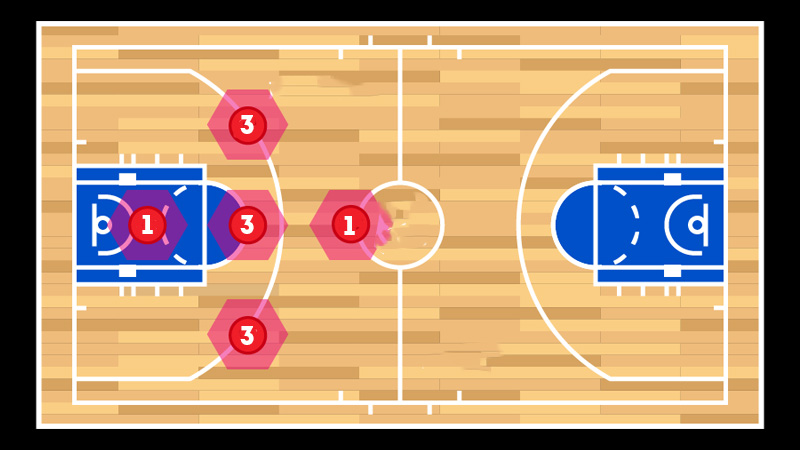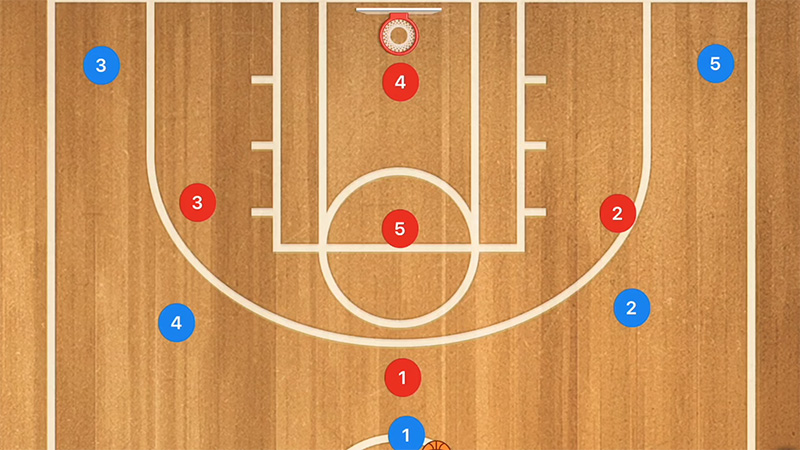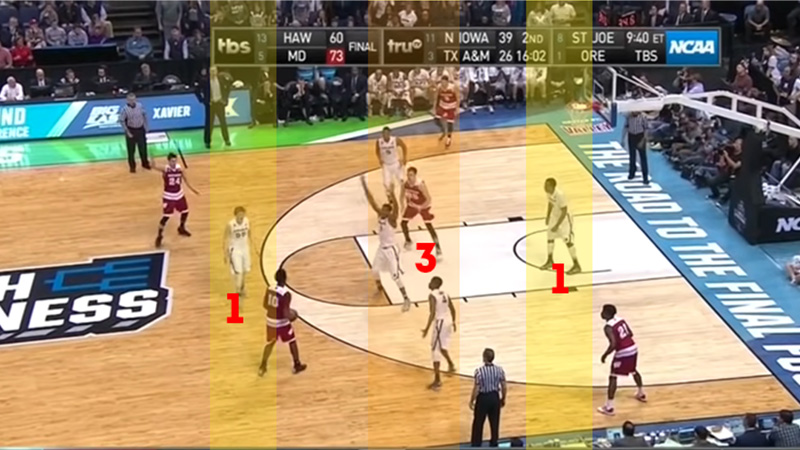Remember! With 2-3 Zone Defense, how alarming it was when the ball reached the high post?
Well, you can neutralize the risk with 131 Zone Defense, with a better advantage to put pressure on the high post including the outside arc.
Basketball teams can perform this unique defense strategy at different levels of play. However, it still leaves the low post and corners vulnerable to the offense.
But how to apply the strategy on the court, is all up to you.
Let’s take a detailed tour of 1-3-1 Zone Defense and learn everything about this defense including its weak points, benefits, and other aspects.
What Is 131 Zone Defense?
You already know the 131 defense is a basketball defensive strategy, based on a zone formation.
In this defense, players position themselves in specific positions on the court and develop a unique defense that is effective against different offensive plays.
It is, undeniably, ideal for both the half court and the full court. Players can have it as a trap defense, soft denial for skip passes, and packed-in to force opponents into faulty outside attempts.
This defense strategy features,
- One defender at the top – The Chaser (C).
- Three defenders formed a line along the free-throw line extended – Left Wing (LW), Right Wing (RW), and Middle (M) or Center.
- One defender down low near the baseline – The Tail (T) or The Warrior (W).
No specific rules are set to where it might work best. But, the defense has proved to work best with tall and strong players.
Don’t worry! Even if you are short on tall and athletic players, with a few adjustments, you can easily get the best out of any team with this defense strategy.
Remember what Don Mayer said,
“Positioning, anticipation, and technique create quickness. Therefore, you can always get quicker”
Below, we are about to explore more details sharing key points, 1-3-1 coverage, variations, and weakness of this zone defense.
In Detail, the Initial Layout of 131 Zone Defense

Source: rookieroad
The name says it all! It’s a 1-3-1 formation. Prepare for the four positions on defense. Here’s an overview of the 1-3-1 zone defense layout.
Set three defenders across the middle of the court. The player in the middle is the center or the middle. Two players standing by the middle player are the wings – left and right.
Your smaller wing should be on the side you’re pushing the dribbler to. Also, your bigger wing should be on the weak side for greater rebounding once you decide to move the dribbler to a specific side each time.
The warrior stands at the bottom zone near the baseline. Quick tips for our coach friend!
Before putting your players in their dedicated zone areas, learn about their athletic abilities. It is essential to put them where they fit in strength and ability.
As a coach, you should select the chaser first, the center second, and pick the warrior third. Go for the wings at the very last.
It has proved to be quite efficient when you select and orient players maintaining the sequence.
Now, let’s take a look at the key principles of 1-3-1 Zone Defense.
How 131 Zone Defense Works?

Understand where to fit your players better on the court. Before we start with the rotations/ coverage of the 1-3-1 zone defense, here are a few terminologies you should be familiar with.
- Main St.:
Between the lane lines, the center of the court stretched from the baseline to the half-court line. We must keep the ball away from Main Street as part of our defensive strategy.
- Curbs:
From baseline to the half-court line, a four-foot zone from the lane lines toward the sideline is the curbs.
- Curbs:
- Alleys:
It is the area that spreads from the baseline to the half-court line, from curb to sideline.
- High Post & Low Post:
In basketball, the area between the block on either side of the lane (also known as the paint) and the halfway point up the lane toward the free-throw line is known as the low post.
Meanwhile, the area between both elbows and the free throw line is referred to as the high post. Learn more about Basketball Elbow here.
- Full Court Press:
In basketball, the full-court press is a defensive strategy where pressure is applied to the offensive team along the length of the court both before and after the inbound pass.
Set up 131 Zone Defense
The first thing you should be focusing on is setting up the defense with strong and suitable players. Follow the steps below and figure out how to put the defense to work.
131 Defensive Players Should Be,
Look for a player with solid rebounding skills in the center. The center and tail surrounding our center should be fast with better prediction skills.
Two players – left and right wings need strength to deliver powerful defense. Hence, have two taller and stronger players set for these two positions.
Initiate 131 Zone Defense
In basketball, against the 131 zone defense, your opponent will be in the 2-1-2 formation. It goes as two players on top, two by the corners while one takes place at the high post.
Step 1: Chaser on The Passing Lane
In 131 zone defense, place your chaser in the passing lane. This way, the ball would stay only on one side of the court.
Call it the full court press of the 131 defense, because the chaser pushes pressure on the ball handler by the side of the court.
However, the chaser must be able to see the ball and the distant guard. It will allow him easy possession of the passing lane.
Remember that, the chaser can have the pass back upon the ball being on the corner, particularly when one player is trapping the corner.
Otherwise, he can guard the high post or top of the key with no one on the corner.
Step 2: Center Takes The High Post
The primary objective of the center is to prevent and hold any potential penetration between our chaser and the wings.
The center should be able to reject any pass to the high post. By taking a full front to the high post, he can easily get the job done, whether there is a player to the high post or not.
In addition to that, the center should be aware of the cutters and post-ups. He can simply shield the block when the ball gets to the corner. And, when the corner is trapped, suggest your center simply get into a denial position.
Step 3: Warrior on The Ball Side Block
The warrior here plays the role of the point guard. It is up to him to rule out any pass led to the corner. He will be assigned to the ball side area and remain there.
Two events can take place,
1) The ball going to the corner: When the ball is in the corner, our warrior will play man-to-man defense to limit any probable drive.
2) Ball getting reversed: However, on the contrary, when the ball gets a fast reverse, the warrior will be under pressure to reach the other corner and prevent any possible scoring opportunities.
Note: A team may attempt to post up the warrior; however, the center will often drop to the ground and trap the ball in the post to make things difficult for the post player.
Everything is at the guard’s baseline, and everything is at the big’s.
Step 4: Wings at The Curbs
In 131 defense, the wings are the most comfortable ones, as they have the simplest job.
The right and left wings have to drive everything toward the top, in the middle of the court. It is also up to them to grab anything they can and attempt to turn every pass into an overhead pass.
The wings have two options when they are on the ball side and the ball goes over their heads and into the corner.
- Corner Trapping: Don’t put your defense at risk by frequently trapping the corner. We accept that corners can be an ideal place to trap.
However, when you often trap the corner, your moves are predictable by the offense. And, you may end up with a vulnerable and weak defense.
One smart tip to skip the loop is, to play as you would as if the ball were at the top, between the ball and their nearest teammate, help side defense, and attempt to bounce or push passes over their heads.
- Guard the Weak Side: Alternatively, when the ball gets to the opposite side of the basketball court, the wings will have different workloads.
Now, they have to cover the weak side block region when the ball is at the top of the court, or close to half-court.
This will ensure, no overhead passes to get to the rim and also, no one gets past them.
Third and additional scenario, the responsibility shifts to playing safety if the ball goes to the opposing corner.
Take note of the openings on the floor and watch out for anyone flashing into them for a simple catch and score.
Now, here are the things you need to know before setting up a 131 zone defense. Select and place your players wisely and make sure they are suitable for their posts.
However, in case you feel like, the major 131 zone defense is not too much comfortable for your team, it offers a few variations. You can try one or two of them on the court too! Read to know more.
Basketball 131 Zone Defense Variations
The 1-3-1 zone defense has a variety of variations. However, the basic principles of the 1-3-1 zone defense remain the same. A little bit of adjustment and we will have another variation of the 1-3-1 zone defense.
As a coach, you can make the best use of 1-3-1 zone defense based on your team’s potential, the opposing team’s play style, and under certain game scenarios.
A Butterfly adjustment is one common variation of 131 defense. It happens when the defensive wing player blocks the offensive wing player from receiving the ball.
Thus, making it challenging to pass back to the wing and preventing the offense from just passing the ball back and forth (We call it Ping-Pong).
The butterfly is an automatic adjustment and should stop the offense effectively from going too far with the ping pong.
Other variations are
- Trapping for turnovers or rushed shots
- Extending the defense (half or full court)
- Zone Press
- Soft denial (for high/slow skip passes)
- Zone shifting
- Double-Team Rotation
- Alternate high/low post blockage
- Plug (center plugs the high post)
The variations we have here are just a few examples of how coaches can tailor the 1-3-1 zone defense.
The success rate depends on the players’ being comfortable with their roles, better communication, and the ability to execute defensive strategies efficiently.
What Are the Cons of 131 Zone Defense?
No defense is free of faults. The 1-3-1 also has a few drawbacks to take into account:
1) The 1-3-1 zone defense needs the defense to thoroughly comprehend all of its moving pieces and apply them from any place on the court.
Therefore, with young clubs, it’s not the ideal option for player development.
Players may play aggressively and effectively in a 1-3-1 formation at the youth level by just getting their hands up and doing so.
These players, however, are not developing sound basics or defensive fundamentals.
2) Some players find the 1-3-1 zone defense tough on their bodies, even if it is a successful strategy.
Players must continue to be active and aggressive in their efforts to disorient the offense. On the other hand, although less effective, the man-to-man defense is also less exhausting.
3) If your players do not have the right concept of coverage, your corners may be vulnerable to outside shots. The same goes for low posts without proper coverage.
4) Take time to guide your team about rebounding. Especially, team them how to rebound outside of their zone because the defense can be vulnerable to offensive rebounds.
Learn more about basketball rebounding here.
5) Players will cover wide areas of the court as part of the 1-3-1 zone defense’s structure.
The baseline, the corners, where the baseline and sidelines connect, as well as the ball-side and weak-side blocks, are all up to the guard closest to the basket.
You can also assign a wing player to the baseline as it opens up a part of the floor including the low post.
Who Can Use 1-3-1 Zone Defense?
We do not recommend the 131 zone defense for young teams (12 years of age and under).
However, you can consider the zone defense for advanced youth teams who have already mastered strong man-to-man defense.
Not to mention that, this zone defense can be extremely effective for college, high school, or advanced middle school squads.
If you want to earn a defensive advantage, you can consider using this tried-and-true defense.
Due to the high flexibility of 131 defense, you can use it as primary defense or as a transition defense shifting from one to another.
Learn More About Zone Defense
To get started with 131 Zone Defense, our guide should do it! But one thing may still poke your head, What if your team can not handle the 1-3-1 defense?
Mark one thing! 1-3-1 defense is a flexible defense strategy. You can modify the terms to your team’s convenience to utilize on the court. Plus, performance and skills evolve on the court.
Your players will improve and become a better version of themselves. They deserve this opportunity too. Start with the practice court and then move forward! Good luck!







